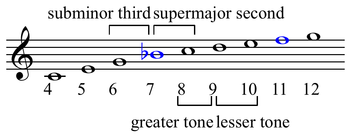Harmonic seventh
| Inverse | Septimal major second |
|---|---|
| Name | |
| Other names | Septimal minor seventh, Subminor seventh |
| Abbreviation | m7 |
| Size | |
| Semitones | ~9.7 |
| Interval class | ~2.3 |
| Just interval | 7:4[1] |
| Cents | |
| Equal temperament | 1000 |
| 24 equal temperament | 950 |
| Just intonation | 968.826 |
The harmonic seventh interval Play (help·info), also known as the septimal minor seventh,[2][3] or subminor seventh,[4][5][6] is one with an exact 7:4 ratio[7] (about 969 cents).[8] This is somewhat narrower than and is, "particularly sweet,"[9] "sweeter in quality" than an "ordinary"[10] Just minor seventh, which has an intonation ratio of 9:5[11] (about 1018 cents), or very nearly an equal-temperament ratio of 2^(5÷6):1 (1000 cents).

The harmonic seventh arises from the harmonic series as the interval between the fourth harmonic (second octave of the fundamental) and the seventh harmonic; in that octave, harmonics 4, 5, 6, and 7 constitute a purely consonant major chord with added seventh (first inversion).
When played on the natural horn, as a compromise the note is often adjusted to 16:9 of the root (for C maj7♭, the substituted note is B♭-, 996.09 cents), but some pieces call for the pure harmonic seventh, including Britten's Serenade for tenor, horn and strings.[12] Composer Ben Johnston uses a small "7" as an accidental to indicate a note is lowered 49 cents (1018 − 969 = 49), or an upside-down "7" to indicate a note is raised 49 cents. Thus, in C major, "the seventh partial," or harmonic seventh, is notated as ♭ note with "7" written above the flat.[13][14]

The harmonic seventh is also expected from barbershop quartet singers when they tune dominant seventh chords (harmonic seventh chord), and is considered an essential aspect of the barbershop style.[15][16][17]

In ¼ comma meantone tuning, standard in the Baroque and earlier, the augmented sixth is 965.78 cents – only 3 cents below 7:4, well within normal tuning error and vibrato. Pipe organs were the last fixed-tuning instrument to adopt equal temperament. With the transition of organ tuning from meantone to equal-temperament in the late 19th and early 20th centuries the formerly harmonic Gmaj7♭ and B♭maj7♭ became “lost chords” (among other chords).
The harmonic seventh differs from the Pythagorean augmented sixth by 225/224 (7.71 cents), or about ⅓ comma.[19] The harmonic seventh note is about ⅓ semitone (≈ 31 cents) flatter than an equal-tempered minor seventh. When this flatter seventh is used, the dominant seventh chord's "need to resolve" down a fifth is weak or non-existent. This chord is often used on the tonic (written as I7) and functions as a "fully resolved" final chord.[20]
The twenty-first harmonic (470.78 cents) is the harmonic seventh of the dominant, and would then arise in chains of secondary dominants (known as the Ragtime progression) in styles using harmonic sevenths, such as barbershop music.
Notes[edit | edit source]
- ↑ Haluska, Jan (2003). The Mathematical Theory of Tone Systems, p.xxiii. ISBN 0-8247-4714-3. Harmonic seventh.
- ↑ Gann, Kyle (1998). "Anatomy of an Octave". Just Intonation Explained.
- ↑ Partch, Harry (1979). Genesis of a Music, p. 68. ISBN 0-306-80106-X.
- ↑ von Helmholtz, Hermann L. F (2007). On the Sensations of Tone. p. 456. ISBN 1-60206-639-6..
- ↑ Royal Society (Great Britain) (1880, digitized 26 Feb. 2008). Proceedings of the Royal Society of London, Volume 30, p. 531. Harvard University.
- ↑ Society of Arts (Great Britain) (1877, digitized 19 Nov. 2009). Journal of the Society of Arts, Volume 25, p. 670. The Society.
- ↑ Andrew Horner, Lydia Ayres (2002). Cooking with Csound: Woodwind and Brass Recipes, p. 131. ISBN 0-89579-507-8.
- ↑ Bosanquet, Robert Holford Macdowall (1876). An elementary treatise on musical intervals and temperament, pp. 41-42. Diapason Press; Houten, The Netherlands. ISBN 90-70907-12-7.
- ↑ Brabner, John H.F. (1884). The National Encyclopædia, Vol. 13, p. 135. London. [ISBN unspecified]
- ↑ "On Certain Novel Aspects of Harmony", p. 119. Eustace J. Breakspeare. Proceedings of the Musical Association, 13th Sess., (1886-1887), pp. 113-131. Oxford University Press (on behalf of the Royal Musical Association).
- ↑ "The Heritage of Greece in Music", p. 89. Wilfrid Perrett. Proceedings of the Musical Association, 58th Sess., (1931-1932), pp. 85-103.Oxford University Press (on behalf of the Royal Musical Association).
- ↑ Fauvel, John; Flood, Raymond; and Wilson, Robin J. (2006). Music and Mathematics, p. 21-22. ISBN 9780199298938.
- ↑ See page 193 in Douglas Keislar; Easley Blackwood; John Eaton; Lou Harrison; Ben Johnston; Joel Mandelbaum; William Schottstaedt (Winter 1991). "Six American composers on nonstandard tunings". Perspectives of New Music. 1. 29: 176–211.
- ↑ Fonville, J. (Summer 1991). "Just Intonation". Perspectives of New Music. 29 (2): 106–137.
- ↑ "About Us".
- ↑ Dr. Jim Richards. "The Physics of Barbershop Sound".
- ↑ The accuracy of this claim has been questioned by empirical data of Hagerman and Sundberg: Hagerman, B.; Sundberg, J. (1980). "Fundamental frequency adjustment in barbershop singing". Journal of Research in Singing. 4 (1): 3–17.
- ↑ Miller, Leta E., ed. (1988). Lou Harrison: Selected keyboard and chamber music, 1937-1994. p. xliii. ISBN 978-0-89579-414-7..
- ↑ "On Some Points in the Harmony of Perfect Consonances", p. 153. R. H. M. Bosanquet. Proceedings of the Musical Association, 3rd Sess., (1876-1877), pp. 145-153. Oxford University Press (on behalf of the Royal Musical Association).
- ↑ Mathieu, W.A. (1997). Harmonic Experience, pp. 318-319. Rochester, VT: Inner Traditions International. ISBN 0-89281-560-4.
Further reading[edit | edit source]
- Hewitt, Michael. The Tonal Phoenix: A Study of Tonal Progression Through the Prime Numbers Three, Five and Seven. Orpheus-Verlag 2000. ISBN 978-3922626961.
| This article uses material from Harmonic seventh on Wikipedia (view authors). License under CC BY-SA 3.0. |
